2019 Specialized Enduro Elite 27.5
Size Tested: Medium
Geometry: (Here)
Build Overview (Elite Build Kit):
- Drivetrain: Sram GX Eagle
- Brakes: Sram Code R
- Fork: Fox Rhythm 36
- Rear Shock: Fox Performance Float DPX2
- Wheels: Roval Traverse w/ Specialized hubs
Wheels: 27.5′′
Travel: 170 mm rear / 170 mm front
Blister’s Measured Weight: 31.7 lbs (14.4 kg) without pedals
MSRP: $4,820
Test Location: Gunnison-Crested Butte Valley, CO
Test Duration: 4 months
[Editor’s Note: Specialized recently released a new 2020 Enduro, which you can learn more about here. This review was conducted on the 2019 version.]
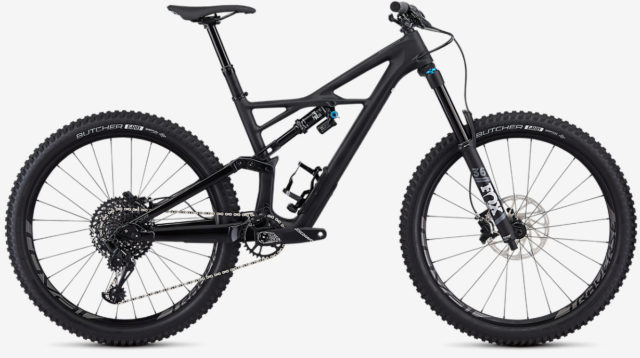
Intro
The Specialized Enduro has been around for 20 years now — (!!!) — with the first model being released long before the Enduro World Series was even a thing. But the latest models of the Enduro bear little resemblance to the original 1999 model, which had a mere 109 mm of rear travel, and came spec’d with an 80mm-travel fork.
Over two decades of the model line, the bike’s travel has grown to 170 mm at both ends for the 27.5” frames (160 mm for the 2019 29ers), the chainring count has dropped from three to one, and the geometry has stretched longer, lower, and slacker into numbers that would have seemed extreme for a Downhill bike in 1999.
But times have changed, and so have bikes. So, how does the 2019 Specialized Enduro compare to the current class of do-it-all long-travel bikes? First we’re taking a closer look at the Enduro, and below you can read our full review.
The Frame
The Enduro Elite comes with a carbon front triangle and an aluminum rear end. The higher-end “Pro” and “S-Works” builds get carbon rear ends, while the lower-end “Comp” build features a fully aluminum frame.
The Enduro features what used to be a proprietary Specialized suspension design — the “FSR” link in Specialized nomenclature, otherwise known as a Horst link. Now that the patent has expired, lots of companies are producing bikes with a similar layout, essentially a four-bar linkage with a pivot on the chainstay, slightly forward of and below the dropout.
For more on suspension designs and how they differ, check out our Suspension 101 article.
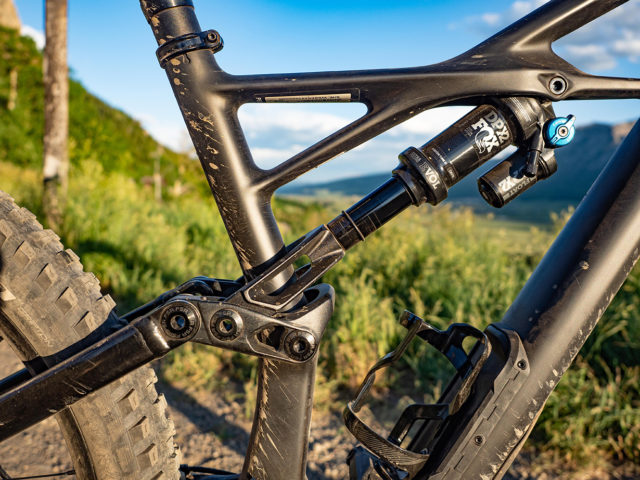
The Enduro has antisquat values at the lower end of what is common for Trail / Enduro bikes, coming in a little under 100% around the sag point in the lower gears. This theoretically should help maintain rear-wheel traction under power when climbing, but comes at the expense of a bit of pedaling efficiency. It’s not a big outlier in this regard (e.g., the Trek Remedy is similar), but it has significantly less antisquat than some other competitors, like the Rocky Mountain Slayer and Devinci Spartan.
All cables on the Enduro are routed internally and setup was super easy. The bike features internal tubes that run through the frame and stick out at the entry / exit points, meaning that you don’t need to fiddle much at all while trying to run the cables through.
On the Enduro’s Elite’s down tube is what Specialize calls the “SWAT” door, which lets you stash all sorts of stuff inside the down tube and the “door” doubles as a water-bottle holder. The cavity inside the down tube is very spacious, and you can fit an extra tube, pump, small tools, and most importantly, lots of snacks. Specialized also includes a small multi tool with a slotted screwdriver, 3, 4, 5, 6, and 8 mm Allen keys, and a T25 Torx. The multitool attaches to the bottom of the SWAT door / water-bottle holder. Of note — the aluminum Enduro Comp does not get the SWAT door.
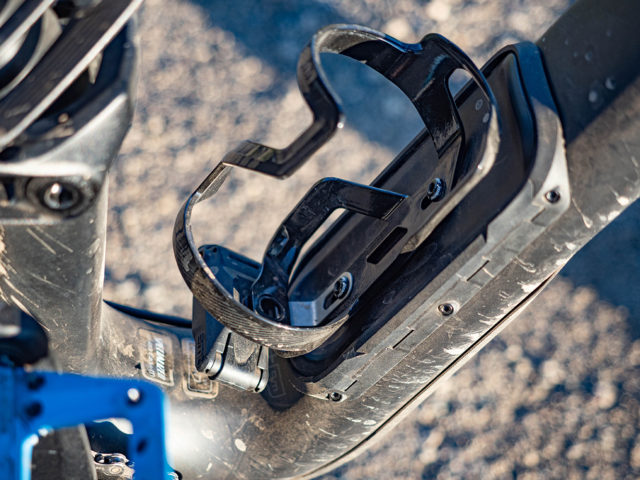
The Enduro’s frame is finished off with cleanly integrated rubber guards along the bottom of the down tube and around the chainstay.
The Build
Here are the quick highlights of the Enduro Elite 27.5 build:
- Drivetrain: Sram GX Eagle
- Brakes: Sram Code R
- Fork: Fox Rhythm 36
- Rear Shock: Fox Performance Float DPX2
- Rims: Roval Traverse 27.5, hookless alloy, 30mm inner width, 2Bliss Ready, 28h
- Front Hub: Specialized, sealed cartridge bearings, 15x110mm spacing, 28h
- Rear Hub: Specialized, sealed cartridge bearings, 12x148mm thru-axle, 28h
- Tires: Specialized Butcher, GRID casing, GRIPTON® compound, 2Bliss Ready, 27.5 x 2.6″ (these actually measure around 2.4” on the 30 mm Roval rims)
- Cockpit: all Specialized-branded aluminum
- Dropper Post: Command Post IRcc, 16-position micro-height adjustable, two-bolt head, bottom mount cable routing, remote SRL lever, 34.9mm, S: 130 mm travel, M/L/XL: 160 mm travel
- Saddle: Body Geometry Phenom Comp, hollow Cr-Mo rails, 143mm
This checks all the boxes for a bike in this class and price point, and stacks up nicely against some other competitive options. Apart from the Specialized-branded parts, the Enduro Elite build is nearly identical to the Transition Patrol Carbon GX build, for example, which retails for $4999.
While nothing jumps out as needing upgrading right away, it’s worth noting that the Enduro uses a proprietary shock mount that limits replacement options, and the 34.9mm-diameter seatpost is a less common size that hasn’t (yet?) been embraced by all seatpost manufacturers.
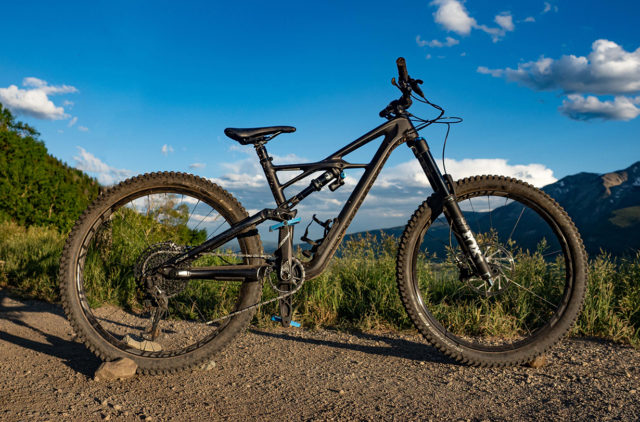
For reference, here are the other build options for the Enduro 27.5 and some quick highlights in terms of components and price:
Enduro Comp 27.5
- MSRP: $3200
- Rockshox Yari RC fork
- Rockshox Monarch Plus shock
- SRAM GX drivetrain (XG cassette)
Enduro Elite 27.5
- MSRP: $4820
- Fox Rhythm 36 Fork
- Fox Performance Float DPX2 shock
- SRAM GX Eagle drivetrain
Enduro Pro 27.5
- MSRP: $6500
- Ohlins RXF 36 fork
- Ohlins STX shock
- SRAM X01 Eagle drivetrain
Enduro S-Works 27.5
- MSRP: $8500
- Ohlins RXF 36 fork
- Ohlins STX shock
- SRAM XX1 Eagle drivetrain
Fit & Geometry
The Enduro’s geometry is pretty middle of the road for a long-travel Enduro bike these days — it’s certainly not dated, it’s but notably not at the forefront of the longer / lower / slacker trend, either. This is especially noteworthy when compared to the rather eye-popping geo numbers on Specialized’s Stumpjumper Evo bikes (63.5° head angle, 465 mm reach, and 1228 mm wheelbase for the smaller “S2” size) . And it’s worth noting that, at least in terms of geometry, the 2019 Enduro is the same as the 2018 Enduro (there are some differences between the two when it comes to build and color options).
For reference, here are some key geo numbers for a size Medium Enduro 27.5:
- Reach: 444 mm
- Head Angle: 65.5°, 65° in low setting
- Wheelbase: 1197 mm
- Chainstay Length: 433 mm (same for all sizes)
- Bottom Bracket Height: 350.5 mm
- Effective Seat Tube Angle: 76.8°
- (A quick measurement with a phone angle-finder app provided an actual seat tube angle of between 73° and 74°.)
For more on geometry numbers and how they affect the fit and ride of a bike, check out our Geometry 101 article.
Some Questions / Things We’re Curious About
(1) Where does the Enduro fall within the growing class of 160-170mm travel bikes? Does it feel like a long-legged Trail bike, or more like a gravity-oriented bike that happens to have some climbing capability? Or something else?
(2) How does the longer-travel Enduro match up against the Stumpjumper Evo, which has less travel, but a much slacker head angle and longer wheelbase? And what sorts of riders would prefer one over the other?
(3) Does the Enduro make sense as an Enduro race bike? Specialized’s EWS team has notably raced a mix of the Enduro (29er) and the Stumpjumper in recent years.
Bottom Line (For Now)
The Specialized Enduro has been a mainstay for two decades now, and it’s not a stretch to say that it helped name an entire discipline of riding and the class of bikes that that discipline spawned. The competition in the class of 160-170mm travel bikes has never been stronger, so in an increasingly crowded marketplace, does the Enduro still manage to stand out? See our full review for our thoughts:
FULL REVIEW
Eric Freson: After we published our First Look of the 2019 Enduro 27.5, Specialized announced the new 2020 Enduro, which is currently only available in a 29” version. The new version is pretty different compared to the one we’re reviewing here, with a new suspension layout similar to the 2020 Specialized Demo and longer and slacker geometry numbers. But given that you’ll probably be seeing a lot of 2019 Enduro’s on the resale market (and the fact that some people may not be fans of the longer and slacker 2020 Enduro), we wanted to get a review up of the 2019 Enduro 27.5.
I had the opportunity to spend three days on the 27.5 Enduro, totaling ~70 miles. Roughly half of those were lift-served riding at Crested Butte Mountain Resort, and the other half were logged during a large alpine epic in the Gunnison Valley. While three rides and ~70 miles isn’t enough to draw full conclusions, it was enough time to get to know the Enduro, and get a pretty good feel for what it’s all about.
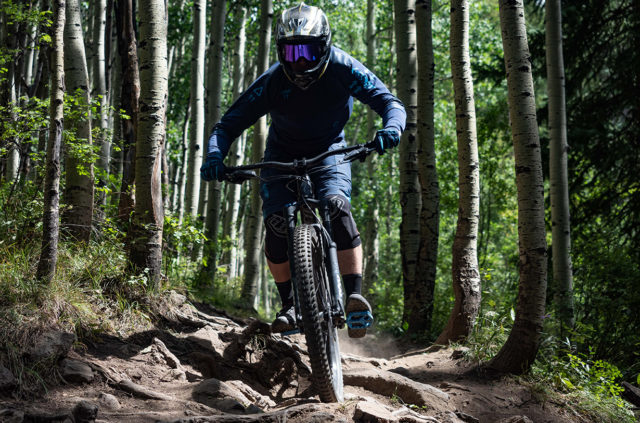
Luke Koppa has also been putting a lot of time on the bike, and at the bottom, he’s offered his perspective on the bike as a newcomer to the sport.
But first, here’s my take on the Enduro Elite 27.5:
The Build
This being Specialized’s mid-range “Elite” level build, I think it has all the building blocks you need for a fast and capable package, all without stressing you out too much if you put a bump or bruise on it here or there. A bike to be ridden hard, not babied.
Some standout parts for me during my time with the Enduro were the brakes, tires, and the shock. The SRAM Code R brakes had wonderful modulation, great power, zero fade (even on huge descents outside the bike park), and impressive lever feel. I may have a set on my next bike.
The Butcher tires gripped well in the conditions I got them in, rolled pretty well, and the GRID casing held up under some very rocky terrain, which tested both sidewall and casing durability. Throwing them into corners under heavy load yielded predictable traction and sharp handling, and they even did ok in the loose-over-hard conditions we so often find in Colorado (though we didn’t get a chance to test them on really wet trails). Finally, the DPX2 exhibited controlled damping, no perceptible fade, and felt like a great fit for the FSR linkage.
For its price and use, areas of potential improvement in the Elite build were pretty minimal during my time with the Enduro. My biggest gripe came in the Specialized-branded bars. I found them lacking in compliance for an aluminum bar, which lead to hand discomfort that I don’t normally struggle with during rides.
The Fox Rhythm fork was also a bit of a mixed bag of performance for me. Low-speed compression and rebound damping were great, but the fork struggled to keep that same smooth feel and composure in high-speed compression scenarios. Aside from feeling significantly harsher when smashing through sections of trail, there was a noticeable top-out sensation when traveling from full compression to full rebound at high speeds.
It was also apparent that a few of the components are already needing a bit of love after the ~500 miles Luke and I have collectively put on the bike. The dropper was prone to making noises on compression, the grips seemed to be wearing quickly, and the SRAM GX derailleur needed a bit of work to get it shifting smoothly. But overall the bike was pretty solid, and put up with my abuse with no complaints.
Fit and Geometry
Jumping onto the Medium Enduro was a simple as dialing in a few suspension preferences, adjusting the seat-post, and letting her rip. The geometry of the Enduro 27.5 generally falls right around the middle of the spectrum when compared to the current aggregate of Enduro bikes. Its numbers are not pushing boundaries, but that’s ok. One number that did stand out a bit more to me was wheelbase — 1197 mm is fairly long for a 27.5” Medium, and I like it that way.
The size Medium Enduro 27.5’s 65° head tube angle, 76° effective seat tube angle, 444 mm reach, 1197 mm wheelbase, and 46 mm Rake all worked well together, creating a neutral ride only requiring light steering inputs for both climbing and descending. This helped a fairly long and not-super-lightweight bike feel very manageable at slower speeds and tighter sections of trail. The handling of the Enduro is neutral enough that I think your choice of build specs is going to have a big impact on the ride quality of your bike. Go with heavy tires + coil suspension? The Enduro would feel way different than if you built up a lightweight build (see Luke’s take for more on this). As it comes, the Elite did ok on mellow, rolling terrain, well on the steep and rocky, and didn’t feel truly out of place in any of the terrain I rode.
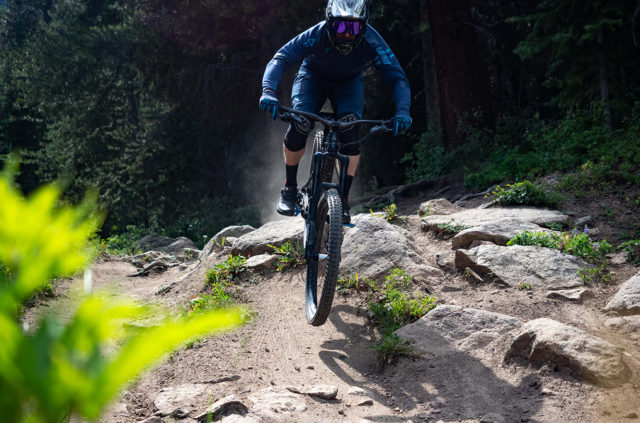
The Enduro’s climbing position felt nice and comfortable, and I didn’t find myself developing hot spots or needing to move frequently to stay in the sweet spot over the bike on the uphill. And for a bike with lots of suspension, wide bars, and a slack head tube angle, I didn’t find the Enduro to be particularly prone to wandering on the climbs, either. Bike manufacturers seem to be figuring this stuff out, and the Enduro is no exception.
At 65°, the head tube angle should be suitably slack for most people. The Enduro preferred terrain that was steeper and faster, but isn’t so long or low that it protested excessively when the terrain wasn’t. The long-ish wheelbase also plays a role here, and when pointed in a straight line, or traveling at a high rate of speed, the Enduro stays incredibly composed.
The Ride
Climbing
Like many Horst-Linkage bikes, the Enduro has an active rear end with relatively low anti-squat numbers, and I often found myself using the compression adjustment on the DPX2 shock. I would say I’m generally sensitive to suspension movement under power, and the Enduro was not a bike I would ride uphill without the ability to lock-out / firm-up the shock.
The caveat to this is that, when trail did get steep and loose, it was a significant advantage to be able to open back up the shock. Doing so provided tons of traction, which helped to keep the rear tire in contact with the ground and build momentum, rather than spinning or bouncing off terrain.
Regardless, this is a bike that enforces a pretty strict “sit and spin” policy. Between 170 mm of rear travel, chunky tires, and active suspension, this really isn’t the bike for the rider who likes to attack on climbs. Short out-of-saddle efforts are rewarded with good traction and subsequent forward progress, but at the end of a 30-mile ride, my legs were also noticeably more gassed than they have been on other bikes I have spent time on recently.
Descending
The Enduro wasn’t the niche bruiser I was expecting it to be. With lots of travel, fairly long geometry, and a stiff chassis, my expectation was that the Enduro would be a pretty specialized (ha) tool. During my time on the Enduro, I found that, yes, it prefers trails on the steeper and faster side of the spectrum. But its light steering inputs, neutral handling, and air suspension helped to make it pretty versatile.
As I mentioned earlier, I think build and suspension setup is going to play a big role in how this bike responds to terrain. It’s not hard to adjust the Fox suspension to suck up everything in its path, and conversely, after I added some PSI’s, the Enduro felt like a more agile bike that rewarded rider input and direction.
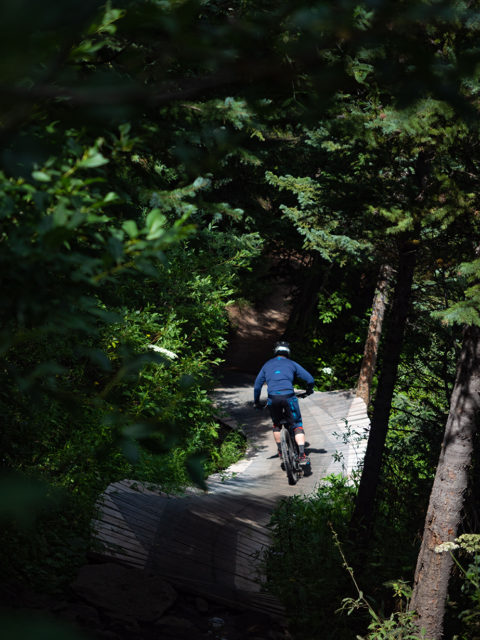
But regardless of sag / PSI setup, I was very impressed by the back end of this bike, and found the FSR platform to do an excellent job with everything from small trail noise to large impacts. The suspension leverage curve felt spot-on and kept me out of the very top and very bottom of the travel unless I was really working to be there (e.g., flat trails or huge impacts). The bottomless feeling, coupled with the well-damped DPX2, yielded a back end with abundant traction, leading to confidence and compliance.
I did struggle a bit more with the front end of the bike, but it was very obvious that with more tweaking, or perhaps a different fork, the chassis had a lot of potential for speed. Good traction abounded, and I found myself pushing through corners where I expected either the front, rear, or both ends of the bike to give up and push out on me. And in a straight line I was able to keep speed and ride through or over trail obstacles I would typically need to adjust for, even on other Enduro bikes. I wouldn’t describe the feel of the bike as overly playful, but for a bike this capable at speed, it isn’t a handful at lower speeds, either.
Compared to the Pivot Firebird 29 (X01 build) and Pivot Mach 5.5 (XT/XTR build), both of which I have been spending a significant amount of time on, the Enduro is overall a more compliant / plush bike. Between the aluminum rear end, lighter-gauge spokes in the wheels, and the FSR linkage, the Enduro does a better job of absorbing trail noise, though at the expense of some precision and power.
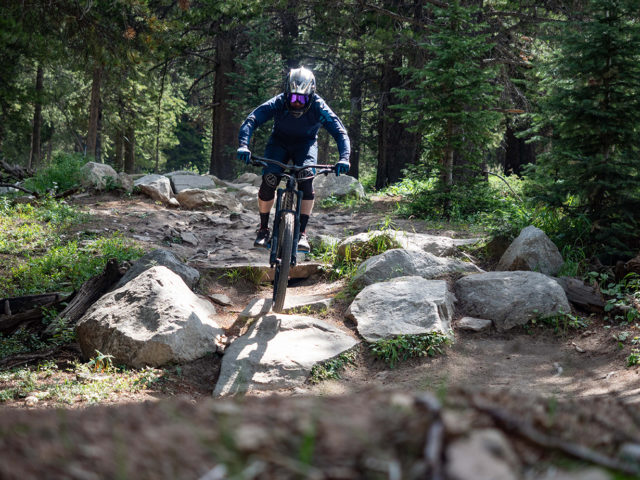
The Enduro’s FSR rear-end rode further in its travel and felt bottomless, but that also meant that it lost some forward momentum compared to the Firebird and Mach 5.5. I find the DW-link Pivot bikes to be much more efficient in transferring power and energy forward, but they don’t offer quite as much trail sensitivity.
The component specs between the high-end Pivots and mid-range Enduro are different enough that it doesn’t feel like a fair comparison, but the Enduro still does a lot with less (in terms of price). Overall, I find the Firebird 29 and Mach 5.5 to be more versatile in a wider range of terrain due to their precision, efficiency, and ability to build speed. But if I rode more lift-served or truly steep terrain, or if I prioritized comfort or traction more than I do, the Enduro would be an excellent option.
Bottom Line
Do you spend some time in the bike park, ride big terrain, or just like lots of traction? The 2019 Specialized Enduro 27.5 is worth a look. Surprisingly versatile and easy, the Elite build provides good value, and the bike is fast. It’s probably not what I would reach for on big all-day epics or instances where efficiency is high on the priority list, due to its travel and active suspension. But if traction, high speeds, and mobbing are on the docket, I think the Enduro 27.5 will serve you well.
A Beginner’s Perspective from Luke Koppa
Luke Koppa: If you’re an experienced rider, you probably don’t need to read this section. Eric has a much better understanding of bikes than I do, so his thoughts will be more applicable to you. But for people like me who are pretty new to mountain biking, I figured I’d include my take on the bike:
Enduro. Buzz word of the industry, and it’s stickered on my bike so everyone knows I mean business and definitely know what I’m doing. Why’d I get the Enduro? Cause big bikes are cool, short-travel bikes are for nerds, and I came to party.
Just kidding. I’ve ridden lots of fun short-travel bikes, I’ve hated some long-travel bikes, and if “coming to party” means going really fast downhill, that’s definitely not what I’ve been doing this summer.
A little background: I finally committed to mountain biking this year, after years and years of hassling from my friends. Prior to this year, I had probably put about 10 days on a mountain bike, like, ever. But since I’m now living in Crested Butte, a world-class MTB destination, I figured it was finally time to pull the trigger. That was one of the best decisions I made this year.
I chose the Enduro 27.5 after spending some time on the current Specialized Stumpjumper, Specialized Stumpjumper EVO, and my friend’s 2019 Specialized Enduro 29 (shoutout to Butte & Co. for the demos!).
I got along well with the Stumpjumper, but given that the Evolution bike park at CBMR is a quick walk from my place, I figured a bit more travel would be nice to have for days riding lifts. And while I liked the Stumpy EVO on the down, its long wheelbase felt a bit sluggish in tighter spots, and thanks to my terrible pedal-cadence awareness, while pedaling it I smashed its low bottom bracket and cranks more times than I could count. I also enjoyed the Enduro 29, but given that I’m not setting any records on the down and wanted to experiment with the more playful aspects of descending, I figured the 27.5 would make more sense.
So, I settled on the Enduro 27.5, and after reading lots of reviews and articles from our much-more-experienced reviewers, I figured the Elite build would offer a nice blend between performance and price. And while my perspective is very obviously biased, I have to give major props to all of our bike reviewers — they do a really, really good job. If you’re looking for a bike, whether you’re new or very experienced, their Mountain Bike 101 articles are extremely helpful. So well done, everybody.
I’ve spent my summer riding almost every day, with roughly 60% of my time in the bike park, and the rest on the trails here in the Gunnison valley. I don’t have Strava (looking at my times would just be embarrassing), but I’d estimate I’ve put somewhere around 500 miles on the bike this summer. So with all that said, here’s my take on how the Enduro 27.5 worked for a very excited beginner who is now fully obsessed with mountain biking.
The Ride
Climbing
I agree with everything Eric said above. The Enduro feels like it has a very active back end, and I resorted to the lockout switch on any climbs that were relatively smooth. On rough trails the Enduro gave me plenty of traction, but out-of-the-saddle efforts made me realize that this bike really excels when you can get your weight on that active back wheel and take advantage of its abundant traction.
To me, the Enduro felt very similar to the Stumpjumper while climbing, with the only discernible differences on my end being that the Enduro was noticeably heavier, and its slacker front end wandered a tiny bit more on steep sections. But even for someone like me who has bad technique and a bad habit of pulling back on my bars during climbs, I never felt like the Enduro’s slacker head tube angle was what prevented me from lacing up a tricky ascent. Instead, it was usually my erratic pedal cadence or botched maneuvers in tight spots.
So, apart from the slightly heavier weight, I didn’t notice any major shortcomings in the Enduro while climbing when compared to the shorter-travel Stumpy. Since I struggle on climbs no matter what, I was happy to deal with the Enduro on the up in exchange for more forgiveness and stability on the down. And the difference on the down was much more noticeable than the up, which is exactly what I wanted.
Descending
The Enduro has been really easy to get along with when its pointed downhill, even for me. I agree with Eric that the bike feels quick to respond to inputs, which was a big plus for me since I didn’t want to be fighting my bike while learning how to get down steep and techy sections of trail. It doesn’t feel quite as nimble or precise as the Stumpjumper 27.5, but the Enduro felt far more playful, quick, and agile compared to a full-on DH bike like the 2019 Specialized Demo 27.5 (which I’ve now spent several days on). It also felt a bit easier to flick around compared to the Pivot Firebird 29 and 2019 Enduro 29.
Eric has a much better understanding of the intricacies of the Enduro’s downhill performance, but all I can really say is that the Enduro has handled everything I’ve been able to throw at it, which included a lot of time in the bike park. It never felt excessively long / sluggish in tight berm trails like Luge at CBMR, but also did a great job of absorbing and rolling over rock gardens on Avery. The Specialized Demo definitely felt more composed in steep, rocky sections and in flat-out straight lines, but the Enduro felt a lot poppier and more responsive / less sluggish.
I agree with Eric in that the Enduro excels on trails that are on the steeper and faster end of the spectrum. But I still liked it on every trail I got it on, even the flatter ones. At least for me and the bikes I’ve spent time on (all of which have had 140 mm of rear travel, or more), none of them make a very flat trail that much more exciting. Sure, if I know I’ll be riding a very mellow trail, I’d choose a shorter-travel bike over a DH bike. But between the Enduro 27.5, Enduro 29, Stumpjumper, and Stumpjumper EVO, I didn’t notice myself having more or less fun on any of the bikes on mellow trails.
The Enduro 27.5 with the DPX2 feels very poppy and playful to me. I can get it airborne with little effort, and its rear end doesn’t feel burdensome at all to get sideways when I work up the courage to do so. Even with 9 clicks of rebound (to account for the flat pedals I use), I’ve found that I can much more easily pop and clear jumps at slower speeds on the Enduro 27.5 than I could on a coil-sprung Demo or coil-sprung Enduro 29.
The Enduro 27.5 didn’t feel quite as precise and lively as a shorter-travel bike like the Stumpy, but the Enduro was a lot more plush and stable on rough trail and was still totally capable of messing around at slower speeds.
Comparisons
2019 Specialized Stumpjumper Comp Carbon 27.5
These bikes feel very similar to me. They’re both quite active while pedaling, and seem to encourage the “sit and spin” approach. To me, I didn’t notice the Stumpy being notably more efficient on climbs, apart from its lower weight.
On very slow, flat trails, the Stumpjumper feels a bit more sensible, but on anything relatively steep, I much prefer the Enduro. It feels more plush and forgiving during big impacts, and I felt much more comfortable pointing it down steep, rocky sections of trail. The Enduro’s longer travel definitely has a role here, but I feel like I noticed its slacker head tube angle more than its suspension. The Enduro seemed to do a better job of rolling over larger obstacles, not requiring me to lean back and lift up my front wheel as much as I did on the Stumpy.
Overall, these bikes share a lot in common. If you’ve tried the Stumpy, like how it pedals, but want something that does a bit better at speed and particularly in steep sections, the 2019 Enduro seems like a great option.
2019 Specialized Stumpjumper EVO Comp Carbon 27.5
Funny story: my Enduro looks a lot like the Stumpy EVO that Butte & Co. has available for demo. They’re both all-black, they both have blue flat pedals, and … I ended up accidentally taking out the Stumpy EVO one day at CBMR, thinking it was my bike. Yeah, I know. I’m an idiot.
It took me a few runs to even notice I was on the wrong bike, which either says something about how similar the Enduro and Stumpy EVO feel, or something about my general level of intelligence. After taking out the EVO out a few times after that embarrassing first experience, I’d say it’s a bit of both. There are some notable differences in my mind.
First, the Enduro feels more plush and forgiving during big impacts. That’s not much of a surprise, given that the Enduro has 20 mm more travel front and back (it’s worth noting that the versions I tested had the same exact fork and shock and the suspension was set up very similarly). In steep sections, the EVO did a slightly better job of rolling over big rocks, which I’d chock up to its much slacker and longer geo numbers. But in tight, bermed corners, the EVO feels more cumbersome and sluggish.
While climbing, the EVO’s front end wandered more and I hit its (very low) bottom bracket and cranks a lot. While it was a bit more capable on really steep trails, the EVO felt like much more of a niche bike to me. For newbs like me who are still figuring things out, the Enduro and its more conservative geometry seemed like a more intuitive and arguably more versatile bike.
2019 Specialized Enduro Pro 29*
*This bike was built with a DVO Diamond D1 fork, DVO Topaz T3Air shock, CushCore inserts, and DH-casing, 2.4” Maxxis DHRII and DHF tires
Eric noted that changing the build and suspension on the Enduro could make it feel like a very different bike, and spending time on my friend’s Enduro 29 with the above build confirmed that.
Obviously, the 29” wheels are a big difference, but I think there’s more to it than that. The Enduro 29 I tried felt much more like a DH bike than my Enduro 27.5. It felt more planted, rolled better over big rock gardens, and overall just felt quieter and more composed on rough trail. The 27.5 version I have felt significantly more nimble and playful (I was swapping bikes with my friend who owns the Enduro 29, and he said the same thing).
So all that is to say is that, if you like the sound of the Enduro 27.5 but want something that’s a bit more inclined to smash down rough trails at higher speeds, going with the 2019 29” version, adding CushCores, heavier-casing tires, and / or changing the suspension can make a very significant difference.
2019 Specialized Demo Alloy 27.5 (w/ Fox Van RC coil shock)
I was surprised by how different these bikes felt, given that, at the time I tried the two, the Enduro was the closest thing to the Demo that you could get in Specialized’s lineup. (The new 2020 Enduro seems more similar to the new Demo.) Some people might be thinking to themselves “well, duh. The Demo is a dedicated DH bike, the Enduro is not.” Fair point, but for beginners like me who may not have ridden any dedicated DH bikes, it was interesting to see how noticeable the difference was, especially cause a lot of reviews of long-travel Enduro / Trail bikes often include phrasing like “descends just like a DH bike.”
For lack of a better word, the Demo just felt like “more” bike than the Enduro. The Demo felt much more planted, was less likely to get knocked off track when bashing it into rocks, required less body adjustment to get over steep rock gardens, and was a lot less poppy on jumps.
When switching between the Demo and Enduro, it always took me a run or two to adjust. The Demo felt almost glued to the trail, while the Enduro was much more lively and playful. Hopping off side hits and jumps in general was much more fun on the Enduro, while I felt much more comfortable hitting rock gardens and berms at high speeds on the Demo.
I was pretty blown away by how much more confident I felt at speed on the Demo, but despite this — and the fact that I spend a lot of time in the bike park — I still don’t think I’ll be buying a dedicated DH bike anytime soon. Since I split my time between regular trails and the bike park, I like not having to readjust to my bike, whether I’m taking a lift or pedaling to the top of descents. Since the Enduro is still plenty capable on the down to make it fun in the park, I’ve been very happy with it, for what I’ve been using it for.
Build, Components, and Durability
Overall, the Enduro Elite 27.5 has served me very well, and I haven’t had any major issues with any of the components.
As Eric noted, the grips are wearing down, and I’ll probably replace them at the end of the season. The bottom bracket is now creaking a bit, and Eric thinks I should probably rebuild the fork (though I haven’t been able to notice the bottom-out or “harshness” issues he mentioned). But those things seem like fairly standard wear-and-tear, and the bike is due for a tune-up anyway. (All I’ve done so far is wash it frequently and mess with the derailleur a bit.)
The Code R bakes have been flawless, I really like their lever actuation, and I’ve never noticed any major fade, despite the fact that I’m on my brakes a lot.
The DPX2 has worked perfectly fine for me. It lets me turn the Enduro into a 32-pound hardtail when I want to, it’s absorbed plenty of impacts, and I haven’t found the bottom-out to feel particularly harsh during my many cased and over-shot landings.
The only notable issue I’ve had is with the SRAM GX derailleur, which I managed to bend within a few weeks of getting the bike. The folks at Butte & Co. helped me get it back into working order, though it has proved to be a bit finicky (it’s prone to come a bit loose). But I looove that low Eagle gear, and when I do have it set up properly, it has shifted well.
The 2.6” Butcher tires in the GRID casing have done their job, and I don’t have any real complaints about them. The lack of transitional knobs took some getting used to right when I got the bike, which is worth noting for other beginners who are learning how to lay over their bike and trust the side knobs on their tires.
But after getting the hang of hard turns in general, I have no issues with the Butcher’s grip. After trying my friend’s Enduro 29 with a 2.4” DHF + DHR combo (DH casing + CushCore inserts), I liked those tires a bit better in loose corners, but the difference wasn’t huge. And I haven’t managed to puncture or tear the sidewalls on the Butcher with the GRID casing, which is impressive since I spend a lot of my time on very rocky trails.
Lastly, the SWAT box is awesome. My friend with the 2019 Enduro 29 likes to talk about how he basically has a mini bike shop in his downtube. If he’s got a mini bike shop in his, I’ve got a mini convenience store in mine. It’s got room for Snickers bars, gummy worms, a bag of chips (with a pin hole to let out the air), and still has space for the less important stuff like, you know, a tube and pump. The only other thing to note is that I’d recommend keeping a close eye on the bolts that attach the water bottle cage to the SWAT door — they’re prone to coming loose, but a bit of Loctite keeps that in check.
Bottom Line
As a newbie who splits my time between trail riding and a lift-accessed bike park, the Enduro Elite 27.5 has been just about perfect for me. It was easy to get along with right away, but hasn’t held me back as I’ve improved. It’s a bit heavy for days with big climbs and its active suspension is not super efficient, but I’m never going to win any races on the uphill no matter what bike I’m on (nor do I have any desire to), so this hasn’t really bothered me. And on the down it has done a great job of providing a forgiving ride without feeling burdensome or lacking in playfulness. The Elite build has also hit a really nice sweet spot between performance and price.
The Enduro 27.5 has helped me have a lot of fun and improve significantly on a very wide variety of terrain, and that’s exactly what I wanted out of this bike. If you’re getting into the sport and get to ride terrain that warrants a bike with this much travel, I think the Enduro is worth a good look.
